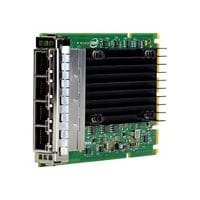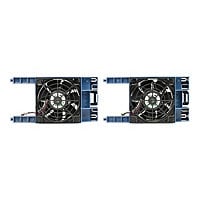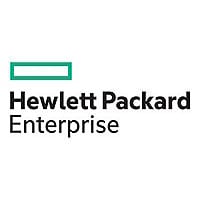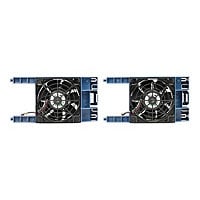Tech specs
1-8 of 102 reviews
What is our primary use case? I use it as a backup of documentation and data. What is most valuable? We are moving on to Veeam backup. The recovery is important. What needs improvement? Veeam Backups provide a stronger capability. It is well-positioned on the radar, with a mature and stable solution. Consequently, it is used throughout the company. For how long have I used the solution? We have been working with it for maybe four years or five. What do I think about the scalability of the solution? It is not as scalable as being backup. Which solution did I use previously and why did I switch? We have not seen artificial intelligence in HP helping with backup processes. When we decided to move into another system, we stopped investigating because we were not really happy with the application, and there are other reasons. We have another solution implemented in the organization with many integrations for active recovery, which are very interesting for us. AI is not mature enough for implementation in critical solutions. We do not foresee the need to have an artificial intelligence app. It is not mature enough. How was the initial setup? I did not handle the setup. I joined the company three years ago, so the platform was already installed. What about the implementation team? We had two people involved in the setup. What was our ROI? We have seen a return on investment and cost savings; I would rate it at five out of ten. What's my experience with pricing, setup cost, and licensing? The setup cost is rated as four out of ten. What other advice do I have? I rate the overall solution a six out of ten. Which deployment model are you using for this solution? On-premises Disclaimer: I am a real user, and this review is based on my own experience and opinions.
What is our primary use case? I use it for backup purposes and backup repositories in six offices, including in Nigeria. How has it helped my organization? We can push our backup files to the cloud, but it is not very effective because it requires a very strong internet connection; it is internet-dependent. The biggest benefits include data protection that comes along with data storage. Restoring data from it is superb. If you have an issue with your virtual machine, you can easily back up the data. StoreOnce is a very okay solution. What is most valuable? It is used for back up to the cloud. Both at the storage level and application level the data is encrypted. What needs improvement? The dashboard needs more improvement. It should be more granular to check the details of the data and the disk. I have to use a third-party solution to check that. AI capabilities are not there yet. Maybe the newer versions will have it. We have been using it for the past five years, so the latest version might have these features. For how long have I used the solution? I have been using it since 2019, so that's five years. What do I think about the stability of the solution? It is a stable product. In the last five years, I never had any issues with the stability. I would rate the stability a ten out of ten. When it is time to upgrade, you upgrade. There is no issue. What do I think about the scalability of the solution? It is scalable and offers good storage. I would rate the scalability a nine out of ten. How are customer service and support? The customer service and support inquired about our needs and how they could help with a backup solution. We had a discussion about the solution's capabilities, and then back up deduplication was activated on both ends. The support was really nice. How would you rate customer service and support? Positive How was the initial setup? It is very easy to deploy and easy to use. The implementation is very straightforward. The data deduplication ratio is also okay. I would rate my experience with the initial setup an eight out of ten, with ten being easy. The deployment takes around 45 minutes. First, get all your IP addresses ready from the network team. Then, connect to the management portal, like laptops, etc. Then, follow the process of checking up on pages and all the parameters. After that, the system is off. It's not that complex; it depends on the environment since it is dependent on the internet. If you connect two to three cables, including the management cable and the network cable for data movement, which is necessary, it's straightforward. Then, all that's left is sharing usernames and passwords and setting up restrictions. The thing is that you need to follow the process, and it gives you the amount of storage capacity. Overall, the implementation is not that complex for someone who has experience. What was our ROI? There are cost savings because of the scalability capability. When we grow, instead of removing HPE servers, we can easily procure new ones. We just look at how many we need based on the terabytes to be added to the environment. So, scalability helps with cost savings instead of requiring the system to be moved out or changed. We can back up data without any issues, and so on. What's my experience with pricing, setup cost, and licensing? The cost is okay. I would rate the pricing an eight out of ten. What other advice do I have? I would rate it a nine out of ten. I would recommend it to people who want to use it for backup; they will enjoy it. It is a good solution for a backup repository. The newer version has all these AI-driven capabilities, which I have yet to use. Which deployment model are you using for this solution? On-premises Disclaimer: I am a real user, and this review is based on my own experience and opinions.
What is our primary use case? I use the solution in my company, and we design the solution per the customer's requirements. What is most valuable? The most valuable feature of the solution is its UI. The product's UI makes it easy for users to configure the tool. What needs improvement? The product's support is an area with certain shortcomings requiring improvements. Support needs to be faster. I don't know whether a snapshot is an area that is covered in the tool or not, but if it is there or incorporated in the tool, then it is good. For how long have I used the solution? I have been using HPE StoreOnce for more than ten years. My company may probably be using the latest version of the solution, but I am not into the implementation part. What do I think about the stability of the solution? Stability-wise, I rate the solution a seven out of ten. What do I think about the scalability of the solution? In terms of HPE StoreOnce's scalability benefits for our organization's growth, I would say that it is possible to scale up as and when there are requirements coming in from our customers. How are customer service and support? I rate the technical support a seven out of ten. How would you rate customer service and support? Neutral How was the initial setup? The product's installation phase is easy. The solution is deployed on an on-premises model. The solution's installation phase takes two to three hours. The solution's installation phase can be managed by two engineers. What's my experience with pricing, setup cost, and licensing? My company has to keep on asking HPE distributors to offer the product at a better price, which is why I cannot disclose it. I don't utilize any licenses, which can be a reason why I have to pay extra money in addition to the standard license fees. Which other solutions did I evaluate? Even though I chose HPE over the other products in the market, I see that some equations have changed, specifically since HPE and Nutanix have started to work together. I did not consider any other tools against HPE StoreOnce. What other advice do I have? The tool fits into your data protection and disaster recovery strategies, specifically for SME customers, as it is the most apt solution for them. Speaking about the features of HPE StoreOnce that are most effective for data replication, I would say that there are DBs in my company for it. I cannot comment whether I have seen any reductions with the costs because of the tool since it is used by my end customers. I believe that if they are still using it, then there shouldn't be any problem with it. I have not faced any challenges when integrating HPE StoreOnce into our company's IT environment. I have not used any AI features in the tool. I would recommend HPE StoreOnce to other users. For an SMB customer, the budget is a constraint, which is why they can think about using HPE StoreOnce. I don't do any maintenance of the product with the help of any third party since I take care of it by myself. If only some requirements are there, we scale up the tool. I rate the tool a six out of ten. Which deployment model are you using for this solution? On-premises Disclaimer: I am a real user, and this review is based on my own experience and opinions.
What is our primary use case? We use HPE StoreOnce for our backup processes. We're backing up Hyper-V and VMware servers through the Data Protector software integrated with StoreOnce. Following the initial backup, we create a backup copy for StoreOnce, and we also have a tape drive connected to a secondary backup level. How has it helped my organization? HPE StoreOnce offers storage capacity for backing up many servers, including virtual machines. Such backups require extensive storage capacity. It provides efficient data duplication and compression capabilities, which help optimize storage usage and reduce costs. One might opt for a larger, more expensive storage solution. For instance, an alternative might have been an 88-terabyte or 48-terabyte StoreOnce model without duplication and compression. What is most valuable? The important feature is compression and duplication. It has a good compression ratio and is very stable. What needs improvement? Some high-level cybersecurity features could be achieved with some entities, and their integration could be built into the store. Backup is a crucial component of any IT setup. Regardless of the products implemented, data safety is compromised without proper backup. Therefore, ensuring the protection of backups is paramount, warranting a high-security zone. While most products claim to be 99.9% secure, no solution can guarantee absolute security. Thus, having a robust backup strategy is essential for achieving near-complete security. For how long have I used the solution? I have been using StoreOnce as a consultant for over 15 years. What do I think about the stability of the solution? I have not faced any issues with the hardware, operating system, software, or virus. It is a very stable product. The product is stable. I rate the solution’s stability a nine out of ten. What do I think about the scalability of the solution? Scalability is an issue. We cannot scale to a huge setup. We need to add the multiple StoreOnce to scale that. Six to seven medium and enterprise I rate the solution’s scalability an eight out of ten. How are customer service and support? They connected us within ten minutes. They fixed the issue and are up and running in no time. How would you rate customer service and support? Positive How was the initial setup? The initial setup is easy and takes two hours to complete. There is a straightforward step-by-step guide. Firstly, we must assign an IP address to the HPE Store once the device connects to the network. Then, we create a virtual library within the device. Next, we integrate it with the backup server and software, configuring it as a storage point for the initial level of backups. What's my experience with pricing, setup cost, and licensing? The pricing is moderate when you compare it with other products. It comes with a warranty when you purchase the product for three years. After three years, they don't have to depend on the model they charge you. What other advice do I have? StoreOnce is suitable for environments and types of solutions. It's adaptable. Backup is a crucial component of any IT setup. Regardless of the products implemented, data safety is compromised without proper backup. Therefore, ensuring the protection of backups is paramount, warranting a high-security zone. While most products claim to be 99.9% secure, no solution can guarantee absolute security. Thus, having a robust backup strategy is essential for achieving near-complete security. Overall, I rate the solution a nine and a half out of ten. Which deployment model are you using for this solution? On-premises Disclaimer: My company has a business relationship with this vendor other than being a customer:consultant
What is our primary use case? Many clients opt for HPE StoreOnce for local backups in a hybrid cloud setup. Larger customers often handle installations internally, utilizing StoreOnce for local backup and a solution like Veeam or Acronis for their private cloud. Most of them prefer the BIM license for this purpose. How has it helped my organization? In my view, using tapes alongside HPE StoreOnce can provide better data protection. While StoreOnce allows for quick data recovery, having tapes as a backup ensures safety in case of StoreOnce issues. I always recommend having both for essential data to minimize downtime. What is most valuable? I think StoreOnce's deduplication technology is crucial for cost efficiency and faster recovery, especially for backup and data protection purposes. Based on my understanding, its impact on data recovery would vary depending on factors like the size of the backup and the scenario in which it's used. For smaller backups or non-production scenarios, the impact may not be significant, but for larger backups or critical production data, there could be a more substantial impact. What needs improvement? In terms of areas for improvement, I believe HPE StoreOnce could learn from competitors like Dell's Data Domain and ExtraHop in refining its architecture. As for rating the initial setup experience on a scale of one to ten, I would rate it as an eight in terms of ease. For how long have I used the solution? I have experience with HPE StoreOnce. What do I think about the stability of the solution? I would rate the stability of HPE StoreOnce as a 7 out of 10. What do I think about the scalability of the solution? In terms of scalability, it's satisfactory as we can expand the StoreOnce solution as needed. Our clients range from medium to large enterprises. How are customer service and support? I haven't personally interacted with HPE support for StoreOnce How was the initial setup? I would rate the initial setup of HPE StoreOnce as a 5 because it's not very difficult but also not extremely straightforward. The deployment typically takes from hours to a couple of days, depending on the customer's requirements and configurations. What's my experience with pricing, setup cost, and licensing? I would rate it around 2 or 3 because, compared to others, it tends to be higher priced. What other advice do I have? I would recommend it as we are an HPE partner and trust their infrastructure and services. However, I always provide honest feedback and mention areas for improvement when asked. I would rate it around a 7. Disclaimer: My company has a business relationship with this vendor other than being a customer:Partner
How has it helped my organization? The solution saves a lot of storage capacity. It provides optimization, compression, and deduplication features. It gives me confidence about the security of the environment. It is integrated with Catalyst and SimpliVity. I can use SimpliVity for backup. What is most valuable? The backups are outside the production network. They are not connected. It is easy to recover the information. It is easy to get access to the environment. I have a lot of storage backups. Catalyst is the most valuable function for data deduplication. I have noticed some improvements in our data retention. The product is very efficient. I have very old backups. I do not have to clean out old backups for a long period. What needs improvement? The solution must provide backup options for smaller capacities. We do not need much storage capacity due to compression and deduplication. We do not use all the capacity. My device is half occupied. The solution must provide cloud management features. A lot of HPE devices and technologies are going to the cloud. I do not know if HPE StoreOnce can be managed on the cloud. For how long have I used the solution? I have been using the solution for eight to ten years. What do I think about the stability of the solution? The tool’s stability has been great. I rate the stability a nine or ten out of ten. What do I think about the scalability of the solution? Small, medium and large organizations can take advantage of the tool’s capacity and performance. How are customer service and support? I am happy with the support team. How would you rate customer service and support? Positive How was the initial setup? The initial setup is simple. The concepts were easy for us. What's my experience with pricing, setup cost, and licensing? I rate the pricing a four out of ten. The solution is pretty expensive. It's not cheap because it's bigger than what we need. What other advice do I have? My storage needs are less, so I did not need to scale the tool. I rate the solution’s management and integration a seven or eight out of ten. HPE is better than other products. It provides good integrations and storage. If anyone asks me what I do to store my backups, I tell them about HPE StoreOnce. I’m happy with the product. We also use it for recovery. Overall, I rate the tool an eight out of ten. Which deployment model are you using for this solution? On-premises Disclaimer: My company has a business relationship with this vendor other than being a customer:Partner
What is our primary use case? We use StoreOnce with Data Protector, the backup and recovery software. We also use it with Micro Focus products. Additionally, StoreOnce has similar functionalities to Data Domain. They both offer NFS data store tools: Data Domain offers ETL and Catalyst Store, while StoreOnce has the equivalent in Catalyst Backup, similar to DD Boost in Data Domain. How has it helped my organization? StoreOnce helps with long-term data retention and disaster recovery strategies. It works similarly to Data Domain. It provides site-to-site replication, like StoreOnce to StoreOnce. Additionally, it offers snapshot backup functionality, just like Data Domain. StoreOnce has built-in ransomware protection, with immutable backup options, similar to Data Domain's automated approach. Finally, it integrates with Veeam, just like Data Domain. So, they're very similar products. However, I have not used StoreOnce in a multi-site environment. We do have implementations with single-site, standalone deployments for many customers. But, I don't have any personal experience with using StoreOnce for multi-site replication, like StoreOnce to StoreOnce for disaster recovery purposes. However, I do have experience with Data Domain's multi-site implementation. Its DR and ER functionalities were good, including the bandwidth-compressed layer application aspects. What is most valuable? I like Catalyst StoreOnce. The performance of Catalyst backup restore is 4.1 gigabytes per second, which translates to roughly 100 terabytes per hour. This is the performance edge StoreOnce has over Data Domain. However, other aspects are quite similar. They both have features like NFS and Catalyst, and neither offers anything significantly different or additional compared to the other. StoreOnce has deduplication functionality built-in. It works across all three of its storage pools: NFS, Catalyst Backup, and DTL. However, the deduplication algorithms and implementation are HPE's proprietary technology and developed in-house. What needs improvement? While StoreOnce has many features, it needs to focus on integrating with third-party backup software solutions. For example, they offer certified integrations with Commvault, but not with EMC Networker, NetBackup for Backup Exec, or Spectrum Protect. Data Domain doesn't face this limitation and integrates well with various third-party software solutions. For how long have I used the solution? I have been familiar with this product for a year. How are customer service and support? My experience with HPE's technical support is very positive. The engineers are available on time, and address issues promptly, and I haven't encountered issues extending beyond one shift. While any vendor can resolve uncomplicated issues quickly, I truly appreciate HPE's approach to problem-solving. I'm impressed with their support structure, call availability, understanding, flexibility in scheduling remote sessions, and accommodating customer timeframes. How would you rate customer service and support? Positive Which solution did I use previously and why did I switch? My experience with Dell spans more than 14 years. However, the switch to HPE from Dell depends on the customers. If a customer specifically wants to switch due to internal factors, designs, or something similar, that's fine. We're here to help them if StoreOnce aligns with their needs and doesn't disrupt their internal operations. However, if they're currently using and satisfied with Dell, and we can offer them additional features and extensions, then we'll do that. It truly depends on the customer's budget and specific needs. But StoreOnce is another option as well. How was the initial setup? The initial setup is not that easy compared to Data Domain. While Data Domain requires maybe 13 or 14 clicks for specific tasks, StoreOnce requires more. The pool creation process is also completely different. We found Data Domain's procedures to be easier and more user-friendly, probably because we're more used to them. While I've implemented a few StoreOnce licenses and migrated back to an HPE partner, my overall experience of 14 years is based on Dell technologies, so I have more experience and find them easier to use. Recently, Data Domain introduced a Capacity Planning DD virtual edition, which helps customers preview and plan capacity needs. Monitoring the data tables is also easier now using that appliance. However, I haven't used anything similar for StoreOnce. What's my experience with pricing, setup cost, and licensing? The price point and possibly the compression and deduplication value of Data Domain are significantly greater than StoreOnce. Otherwise, they offer similar features and functionalities. Which other solutions did I evaluate? Dell's deduplication technology is on par with HPE's. Both products deliver similar results and outcomes. However, their internal processes might differ. The structure is the same, but Data Domain uses an inline source-based approach with deduplication, while StoreOnce has its own method and different terminology for similar functionality. Ultimately, both products offer similar features and are competitors in the market. What other advice do I have? Overall, I would rate the solution a seven out of ten. Disclaimer: My company has a business relationship with this vendor other than being a customer:Partner
What is our primary use case? We use the product for data backup purposes. What is most valuable? The platform's most valuable feature is Catalyst software. It helps with efficient source deduplication. What needs improvement? They could provide more options for storage capacity. At the moment, they only have an 80-terabyte storage facility. There should be availability of lesser capacities at lower prices. Additionally, they should integrate it with cybersecurity products. For how long have I used the solution? We have been using HPE StoreOnce for ten years. What do I think about the stability of the solution? I rate the platform's stability a nine out of ten. What do I think about the scalability of the solution? The platform is suitable for enterprise companies. I rate the scalability a seven out of ten. How are customer service and support? They could improve the technical support services in terms of quality. How would you rate customer service and support? Positive Which solution did I use previously and why did I switch? We have used Dell EMC Data Domain before. In comparison, HPE StoreOnce has an excellent support service. How was the initial setup? The initial setup process is simple. What's my experience with pricing, setup cost, and licensing? I rate the platform's pricing a seven out of ten. What other advice do I have? HPE StoreOnce optimizes the backup and recovery process through its efficient software, notably the Catalyst software, in terms of speed. The integration of StoreOnce with external software, such as Veeam, further contributes to optimizing backup and recovery. It is a scalable platform. We can add extensive units and storage capacity. However, it is quite expensive. I rate the ease of management and integration of HPE StoreOnce an eight out of ten. Overall, I rate the product an eight out of ten. It could be compatible with different systems. Which deployment model are you using for this solution? On-premises Disclaimer: My company has a business relationship with this vendor other than being a customer:Integrator

















